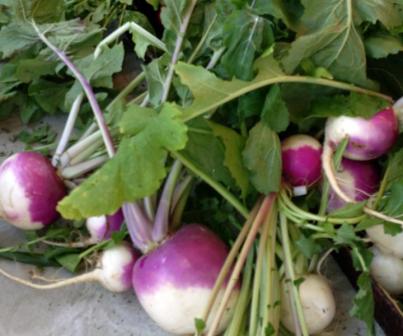Ah, the humble turnip… my all-time favorite vegetable. Beautiful, smooth white-and-purple painted globes of goodness, often with a flat bottom. I always think of Beatrix Potter’s wonderful drawings. So many varieties of turnips to plant, taste and enjoy!
My first taste of turnips occurred at my friend’s mom’s house. She served a delicious dinner of sliced ham, creamed onions, sweet potato and buttered turnips. The turnips were scrumptious. I’ve been cooking and eating them with great gusto ever since.
Fun Facts About Turnips:
Brassica rapa is the official name for turnip… “rapa” shows up again in “broccoli rabe,” and broccoli rabe is part of the turnip family! You can sub in turnip greens when cooking recipes that call for broccoli rabe.
Turnips were originally grown in parts of Europe and Asia.
Turnips were once as popular in America as tomatoes are today.
If left to their own devices, turnip seeds will cross breed with broccoli rabe, Chinese cabbage and Chinese mustard.
Turnips contain as much Vitamin C as an orange.
Turnips are a good source of iron. A serving contains roughly 1/3 the amount as a serving of calves liver.
Turnips also supply vitamin B6, calcium, phosphorus and manganese.
Turnips are among the more sugary/starchy vegetables such as carrots and sweet potatoes. If you are diabetic you may want to consult with your doctor or dietician about what is an appropriate serving size for you, before eating. Ultimately though, one would think that the fibrousness of the turnip would slow down the process of digesting the sugar, making them a healthy choice when consumed in moderation.
Turnips don’t always dress in purple-splashed white. You’ll find round ones, finger-shaped ones, small ones and big ones, in an array of colors. Rutabaga, that big, dense ball that you typically see coated with paraffin at your grocery store, is in the turnip family as well.
This article from Berkeley Wellness, California, cites “an astonishing number of turnip varieties.”
How to Plant Turnips in NJ Zone 6:
Direct-sow turnip seeds any time during the last 2 weeks of March. (I’m going to try planting them this year – I’ll let you know how it goes!)
Sprinkle the seeds over a raised garden bed that has been well raked and fluffed. Try to make it so there are only 3 or 4 seeds every 2-4 inches. Cover with a thin layer of mulch, and water well.
When the turnip plants begin to crowd each other, thin them by snipping away unwanted extras at the stem. (If you pull the plants you want to get rid of, you may damage the “good” plant). Cover with more mulch, and keep damp.
In your garden, the turnips will like to hang out near the lettuce, radishes, spinach and beans. They’ll be ready to harvest in about 2 months, when the roots poke up from under the soil.
Turnips in Recipes:
Slice them up, along with white potato, sweet potato, parsnip and onion. Arrange in a baking dish and drizzle with oil. Sprinkle with salt and an herb such as rosemary. Bake until tender on the inside and a bit crusted on the outside. Chop fresh parsley and sprinkle on top after cooking.
Simmer chopped turnips with potatoes and a few garlic pieces, until tender. Drain well. Mash with potato masher and return to pan along with butter, salt, pepper and a splash of milk.
Here’s a great article on turnips from Mother Earth News!
Our 95-page Organic Gardening E-Guide is Available for Online Purchase
We have included detailed information on planting and growing garden vegetables in NJ Zone 6. This guide is ideal for new gardeners who live in New Jersey and have little to no clue about how to start a garden on their own.
Click the below button to download your copy of our 95-page organic gardening guide today!
